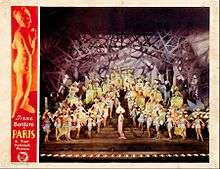Paris (1929 film)
| Paris | |
|---|---|
 theatrical poster | |
| Directed by | Clarence G. Badger |
| Produced by | Robert North |
| Written by |
Martin Brown E. Ray Goetz Hope Loring(titles) |
| Starring |
Irene Bordoni Jack Buchanan Louise Closser Hale Jason Robards Sr. ZaSu Pitts |
| Music by |
Cole Porter Edward Ward |
| Cinematography | Sol Polito |
| Edited by | Edward Schroeder |
Production company | |
| Distributed by | Warner Bros. Pictures, Inc. |
Release dates |
|
Running time | 97 minutes |
| Country | United States |
| Language | English |
Paris is a 1929 American Pre-Code musical comedy, filmed with Technicolor sequences: four of ten reels were originally photographed in Technicolor. Paris was the fourth color movie released by Warner Bros.; the first three were The Desert Song, On with the Show and Gold Diggers of Broadway, all released in 1929. (Song of the West was actually completed by June 1929 but had its release delayed until March 1930). The film was adapted from the Cole Porter Broadway musical of the same name. The musical was Porter's first Broadway hit. No film elements of Paris are known to exist, although the complete soundtrack survives on Vitaphone disks. The sound tape reels for this film survives at UCLA Film and Television Archive.
Paris was the fourth movie Warner Brothers had made with their Technicolor contract. Paris used a color (Technicolor) process of red and green, at the time it was the third process of Technicolor.[1][2][3]

Plot
Irene Bordoni is cast as Vivienne Rolland, a Parisian chorus girl in love with Massachusetts boy Andrew Sabbot (Jason Robards Sr.) Andrew's snobbish mother Cora (Louise Closser Hale) tries to break up the romance. Jack Buchanan likewise makes his talking-picture debut as Guy Pennell, the leading man in Vivienne's revue.
Cast
- Irene Bordoni - Vivienne Rolland
- Jack Buchanan - Guy Pennell
- Louise Closser Hale - Cora Sabbot
- Jason Robards - Andrew Sabbot
- ZaSu Pitts - Harriet
Production
Warner Bros. paid the celebrated French music hall star and Broadway chanteuse Irene Bordoni $10,000 a week to star in this film, playing the role she had originated on Broadway, introducing the enduring Porter standard "Let's Do It, Let's Fall in Love". While this film was being shot, the studio was in the process of completing their all-star revue The Show of Shows (1929), so they had Bordoni film a number for the revue. Their initial intention was to have Bordoni star in two musical features, but due to the poor box-office reception of Paris, they decided not to make any more films with her.[4]
Songs
|
Advertisement
Paris utilized advertisements of a type which were common for its time, featuring the talking in the film and Irene Bordoni starring. One ad for Paris said "See the talking picture of the future".
See also
References
- ↑ The American Film Institute Catalog Feature Films: 1921-30 by The American Film Institute, c. 1971
- ↑ Paris at silentera.com
- ↑ 1957 MOVIES FROM AAP Warner Bros Features & Cartoons SALES BOOK DIRECTED AT TV
- ↑ Paris, original Broadway production at the Music Box Theatre, October 8 1928 to March 23 1929 totaling 195 performances; IBDb.com
External links
- Paris at the Internet Movie Database
- Paris at the TCM Movie Database
- Paris at AllMovie